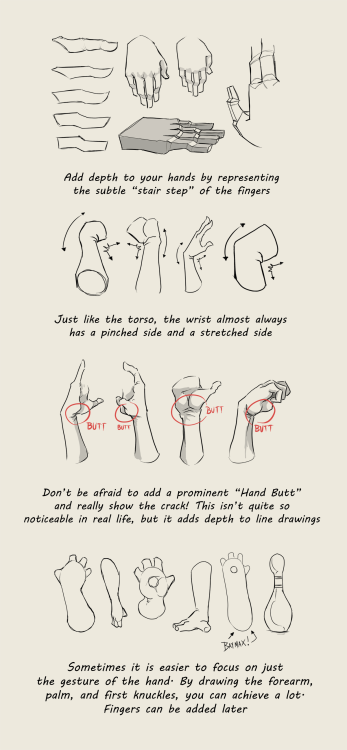batsquatchstudios:The big post of things about hands!!!I don’t consider myself qualified to te
batsquatchstudios:The big post of things about hands!!!I don’t consider myself qualified to teach art at this point in my life, but I don’t see any harm in sharing observations I have made. In learning to draw hands over the past few months I’ve tried to take a lot of notes, with the end goal of hopefully creating a video tutorial one day. I personally learn better from videos than written or illustrated instructions, but I’ve never found any one video that really demystifies drawing hands.I believe that in order to tackle such a difficult subject it is important to understand what makes it difficult, and this is not often addressed. If you understand the problems you can systematically solve them…Drawing the hand is almost like drawing a whole person. Similar number of “major masses” and a big range of motion.Because the hand is so versatile, it’s hard to pick a pose when practicing. Most individual body parts are drawn from different angles, whereas the hand must be drawn from different angles and in different poses. Hands have a lot of moving parts and from any given angle many of these will be partially or wholly obscured by other parts. Drawing “through the form” results in confusing construction lines that are difficult to interpret. Hands are expressive and give big clues as to what a character is doing. Odd or unnatural hand poses detract heavily from your overall piece. Most people avoid drawing hands because of this. The thumb flexes along a different plane than the four fingers and sits on its own deviant metacarpal. Drawing the hand in perspective is hard enough, but adding the thumb in relation to the rest of the hand at a convincing angle? Forget about it! Hands are typically simplified into box and cylinder forms, but almost every part of the hand is a combination of angles and curves. No one simplified form really describes these parts. Hands interact with other objects, like all the time. They’re tricky enough to draw on their own… this isn’t helping anyone. Hands have a lot of bony landmarks, veins, and tendons, all visible at the surface level. These are obstacles when trying to render them realistically. Hands are asymmetrical from every angle. Every part, every time. I think that about covers the major issues we face when trying to draw hands. Now here are some observations and facts that you can use to fight back! The width of the first three fingers (index, middle and ring) is the same as the width of the wrist. The pinky and thumb both emanate from the parts of the palm that overhang this line. The palm of the hand is more of a pentagon than a rectangle (Thanks, Jim Lee!). The length of the middle finger is approximately the same as the length and width of the palm. The length of the phalanxes (finger bones in this case) diminishes in size as they get further from the palm. The second (middle) phalanx is 2/3 the length of the first (proximal), and the third (distal) is 2/3 the length of the second. You don’t really notice this since the first knuckle is “inside” the palm and we tend to think of the fingers as starting at the “finger crotch”. The thumb has no middle phalanx, only a proximal and a distal one. The thumb is rotated 90 degrees from the angle of the four fingers. So the fingernails point “up” and the thumbnail points “to the side”. This obviously changes depending on the pose, but the thumbnail never really points “up” with the other fingernails unless it is bent backwards, as in poses when all five fingers are pressed against a flat surface. It never really points “down” unless the hand is clamping or pinching… or operating a sock puppet. The thumb has to sit lower than the palm so that it can flex underneath the hand. The first knuckle of the thumb is almost as far below the index finger as the pinky is far away from the index finger. The “webbing” of the thumb connects exactly half way up the palm. Hands are asymmetrical from every angle. Every part, every time. That is all the knowledge I have so far, and now you have it too! I don’t think any tutorial, video or otherwise, can ever teach you as much as the thousand observations you will make from drawing a thousand hands. There is no substitute for practice. So practice by looking at your hand from the normal vantage point, and from a mirror. Practice from 3D reference like the Handy Art Tool. Practice by copying other artists and animators whose hands appeal to you. Most of all, practice from imagination.PRACTICE!Below is every reference that I can remember that I’ve personally used while practicing hands: http://www.handyarttool.com/ http://youtu.be/BAQb-5VKxmg http://nk-chan.deviantart.com/art/mini-hand-tutorial-68320552 http://kibbitzer.deviantart.com/art/Hands-Reference-321600866 http://kibbitzer.deviantart.com/art/Hands-Reference-2-322546252 http://kibbitzer.deviantart.com/art/Hands-Reference-3-330102275 http://kibbitzer.deviantart.com/art/Hands-reference-4-428109721 http://characterdesignnotes.blogspot.com/2010/09/hand-reference.html http://characterdesignnotes.blogspot.com/2010/09/hand-reference-part-two.html http://characterdesignnotes.blogspot.com/2010/11/hand-reference-part-three.html Do me a favor and share this around, will you? We could all use more light shed on this subject.-Aaron -- source link
Tumblr Blog : www.batsquatchstudios.com
#reference#anatomy

